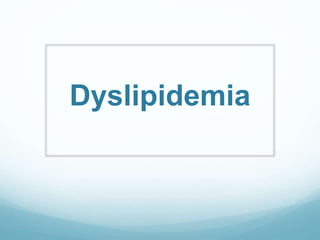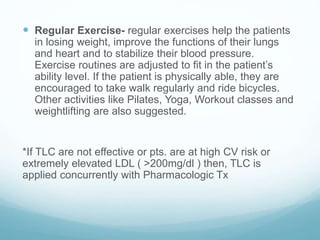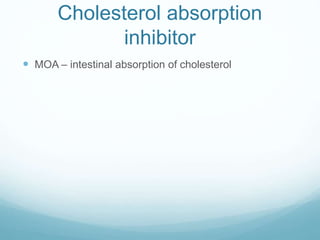Dyslipidemia
- 1. Dyslipidemia
- 2. Introduction ï Cardiovascular dse affects >70 mil Americans - underlying dse largely preventable ï Increasingly aggressive approach in the treatment of cholesterol - NCEP ATP III guidelines
- 3. Epidemiology ï Total cholesterol & LDL Cholesterol increase throughout life - Atherogenic pattern characteristic of Western society diets ï More than 50% of American adults 20y of age or older have elevated total cholesterol - 1/3 are aware of it
- 4. ï Dyslipidemia â (aka hyperlipidemia, aka hypercholesterolemia) is a disorder of elevated or abnormal levels of lipids and/or lipoproteins in the blood, characterized by high cholesterol, triglycerides (TGs) or both, or low HDL levels. - a complex disease caused by the interplay of genetic, dietary and physiologic factors - LDL âĨ 130mg/dl (borderline high or higher) Diagnosis - by using fasting lipoprotein profiles and measuring plasma levels (total cholesterol, TGs, Lipoproteins)
- 5. Classification of Dyslipidemia ï Phenotype. Dyslipidemia is present in the body. You can easily see that the type of lipid that has been increased. ï Etiology. This classification tackles more on the reason why the condition has happened. The reasons may include genetic or secondary to another conditions.
- 6. LIPID METABOLISM (Normal Physiology)
- 8. Dyslipidemia Cause ï Primary Causes. (Familial) Overproduction and defective clearance of the cholesterols TG and LDL is the result of the mutations of single or multiple genes. The primary disorders are the common dyslipidemia causes to the children, although it may not affect in the most cases of adult dyslipidemia. ï Secondary Causes. Adults are the most affected ones when it comes to secondary causes. The causes contribute a lot on how an adult will be affected with dyslipidemia. The sedentary lifestyle is the most essential secondary cause. The lifestyle includes excessive dietary intake of cholesterol, trans fats and saturated fats. Trans fats are the fatty acids that are either polyunsaturated or monounsaturated, in which there are added hydrogen atoms. Trans fats are usually used in a lot of processed foods.
- 9. Other secondary causes are: ï Alcohol overuse Cigarette smoking ï Inactivity ï Diabetes mellitus ï Hypertension & Obesity ï Chronic kidney disease ï Hypothyroidism, Liver disease ï Low HDL < 40mg/dl ï Age and Gender ( Men >45yo, Women >55yo ) ï Other cholestatic liver diseases and primary biliary cirrhosis. ï Drugs like thiazides, retinoids, estrogens and glucocorticoids, among others.
- 10. ï Dyslipidemia Symptoms ï Dyslipidemia doesnât have symptoms at all, but it can cause other symptomatic vascular disease, like coronary artery disease. ï Eyelid xanthelasmas, tendinous xanthomas at the elbow, knee tendons and Achilles and arcus cornea are caused by high levels of LDL. Acute pancreatitis is caused by high levels of TGs. ï Patients that have familial hypercholesterolemia in homozygous form can have the above findings with planar xanthomas. Patients that have elevation of TGs in severe condition can expect having eruptive xanthomas over their elbow, back, trunks, knees, buttocks, feet and hands. Those with rare dysbetalipoproteinemia can expect having palmar xanthomas and tuberous xanthomas. ï Retinal arteries and veins can have a creamy white appearance due to the severe hypertriglyceridemia. You can also have a milky appearance in your blood plasma when you have high lipid levels. You can expect symptoms like paresthesias, confusion and dypsnea.
- 14. Determining Goal ï Identify presence of clinical atherosclerotic dse (high risk) ï Determine presence of major risk factors ï Cigarette smoking ï HTN (BPâĨ 140/90 or uncontrolled or on meds) ï Low HDL (<40mg/dl) ï Family history of premature CHD ï Age ( men âĨ 45 , women âĨ 55) ï Determine Framingham risk
- 19. Dyslipidemia Treatment A. Non-Pharmacologic Treatment ï Therapeutic Lifestyle Change- diet plans include foods that are low in cholesterol and calories and trans-fat free. Foods that are sugary and fried must be avoided. Dairy products and red meat are taken in moderation. In order to lower their cholesterol level, it is recommended that patients should eat fish, vegetables, nuts and fruits. -eat in smaller portions and avoid their cravings. - 3 months trial for all patients ï Smoking Cessation ï Physical Activity ï Weight Loss ï Dietary Modification ï -Reduce saturated and âtransâ fats ï Increase Fiber (25g/day) and complex carbohydrates
- 20. ï Diet remains cornerstone of therapy ï LDL lowering of 25% ï Exercise to increase HDL ï Cardioprotective affect ï Non-prescription agents ï Garlic (-6%) ï Soy protien (-9%) ï Vitamin E reduces efficacy of statins and niacin
- 21. ï Regular Exercise- regular exercises help the patients in losing weight, improve the functions of their lungs and heart and to stabilize their blood pressure. Exercise routines are adjusted to fit in the patientâs ability level. If the patient is physically able, they are encouraged to take walk regularly and ride bicycles. Other activities like Pilates, Yoga, Workout classes and weightlifting are also suggested. *If TLC are not effective or pts. are at high CV risk or extremely elevated LDL ( >200mg/dl ) then, TLC is applied concurrently with Pharmacologic Tx
- 23. Lipid lowering drugs B. Pharmacologic Treatment Omega-3 fatty acids (fish oil)
- 24. Statin ï Synthesis of LDL cholesterol ï LDL lowering 10-70% ï Other benefits ï Reduce plasma viscosity ï Decrease platelet aggregation ï Decrease C-reactive protein levels Adverse effect - Elevated LFT â obtain LFT at baseline, routine monitoring is necessary - Rhabdomyolysis w/ acute renal failure and or myopathy â baseline CPK and recheck CPK if symptoms suggest myopathy; patient should be instructed to report unexplained muscle pain, tenderness, weakness, brown urine; d/c if CPK is markedly elevated or myopathy is suspected
- 25. Bile Acid Sequestrants ï Rarely used ï Bind bile acids in the intestinal lumen ï Increased clearance of cholesterol from blood ï Poorly tolerated (GI effects, Constipation, aggravate GI conditions â IBS, Crohnâs) ï Mild LDL lowering ï Increase HDL
- 26. Nicotinic acid (Niacin) ï Modifies plasma lipoproteins and lipids favorably ï Effects on lipids ï LDL: dec 14% ï HDL: inc 25% ï TGs: dec 30% ï Preferred agent for patients with low HDL in whom therapeutic lifestyle changes have already been tried ï Niacin 500-1000mg PO QHS ï Pre-treat w/ ASA 325mg PO 1-2hrs before dose to avoid ADRs (flushing, pruritus, Gi distress) Adverse Effect - Flushing â taking aspirin 30 mins before aspirin, taking niacin at bedtime w/ food, avoid hot beverages, spicy foods and hot shower at time of administration - Hyperglycemia â caution w/ diabetes - Upper GI Distress - Hepatotoxic â monitor LFT 6-12 weeks
- 27. Fibrates ï Regulate genes that control lipid metabolism ï Indicated for hypertriglyceridemia with low LDL ï GI disturbances Adverse Effect - Gallstones â increase fluid intake, d/c if gallstones are found - Myopathy â baseline CPK - - Increase hepatic transaminase â monitor LFT every 3 months
- 28. Fish Oil ï Omega-3 fatty acids ï Decrease triglycerides by 20-50% ï 1-4g PO QD ï Chill capsules to increase palatability Long-term intake results in increased HDL
- 29. Cholesterol absorption inhibitor ï MOA â intestinal absorption of cholesterol
- 30. ï Dyslipidemia in Diabetes Diabetics with dyslipidemia are diagnosed to have low HDL cholesterol and too many triglycerides. Patients of type 2 diabetes have higher risk of having this condition. The risk factors are having high blood glucose, being obese, and resistant to insulin. And with the combination of these two conditions, there is a consequence of having poor control of their diabetes. Those diabetics with no dyslipidemia can develop one for no apparent reasons like kidney diseases and hypothyroidism. Patients with dyslipidemia can develop diabetes in the future, according to studies. Female patients that have diabetes can have higher risk of cardiac disease because of this form.
- 31. There are no great limits to growth because there are no limits of human intelligence, imagination, and wonder. Ronald Reagan
- 32. Thank you.
































